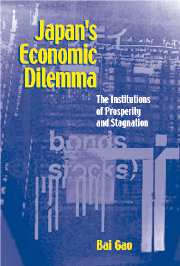Book contents
- Frontmatter
- Contents
- Acknowledgments
- 1 Introduction
- 2 Three Theoretical Issues
- 3 The Rise of the Principles of Coordination and Stability
- 4 Coordination, Excessive Competition, and High-Speed Economic Growth
- 5 Stability, Total Employment, and the Welfare Society
- 6 The Roads to the Bubble
- 7 The Struggle of the Welfare Society
- 8 Fighting the Stagnation
- References
- Index
8 - Fighting the Stagnation
Published online by Cambridge University Press: 07 January 2010
- Frontmatter
- Contents
- Acknowledgments
- 1 Introduction
- 2 Three Theoretical Issues
- 3 The Rise of the Principles of Coordination and Stability
- 4 Coordination, Excessive Competition, and High-Speed Economic Growth
- 5 Stability, Total Employment, and the Welfare Society
- 6 The Roads to the Bubble
- 7 The Struggle of the Welfare Society
- 8 Fighting the Stagnation
- References
- Index
Summary
My analysis of the reversion of the Japanese economy from prosperity to stagnation pays special attention to the rise of the bubble. As any bubble would eventually burst, I believe, the crisis of the Japanese economy in the 1990s was all but inevitable. In this chapter, I show that the deepening of the economic crisis was driven by a reversion of the institutional logic: when control and monitoring were suddenly strengthened in the big bang reform in 1996, the old growth engine of excessive competition lost its fuel; and, when the total employment strategy began to lose ground in the worst economic crisis since World War II, Japanese consumers, whose future incomes relied on their jobs, dared not spend money. As both corporate investments and consumer spending remained low, the Japanese economy continued to stagnate in spite of the budget deficits generated by government stimulation packages. I first analyze how the new developments in the dilemmas I have defined drove the Japanese economy into stagnation and economic crisis in the 1990s. Then I make some reflections on the theoretical implications of this study and discuss the future prospects of the Japanese economic system.
THE BURST OF THE BUBBLE
According to Miyazaki Yoshikazu (1992), the burst of the bubble spread its effects over the Japanese economy through three channels: corporations, banks, and individual households.
In the 1980s, Japanese corporate finance had experienced a rapid shift toward direct financing. Through equity financing, big corporations issued a total of 12.2 trillion yen in stocks, convertible bonds, and warranted bonds in 1988, and 22.9 trillion yen in 1989. Equity finance constituted 27.5 percent of the total capital supply in those two years.
- Type
- Chapter
- Information
- Japan's Economic DilemmaThe Institutional Origins of Prosperity and Stagnation, pp. 243 - 274Publisher: Cambridge University PressPrint publication year: 2001



